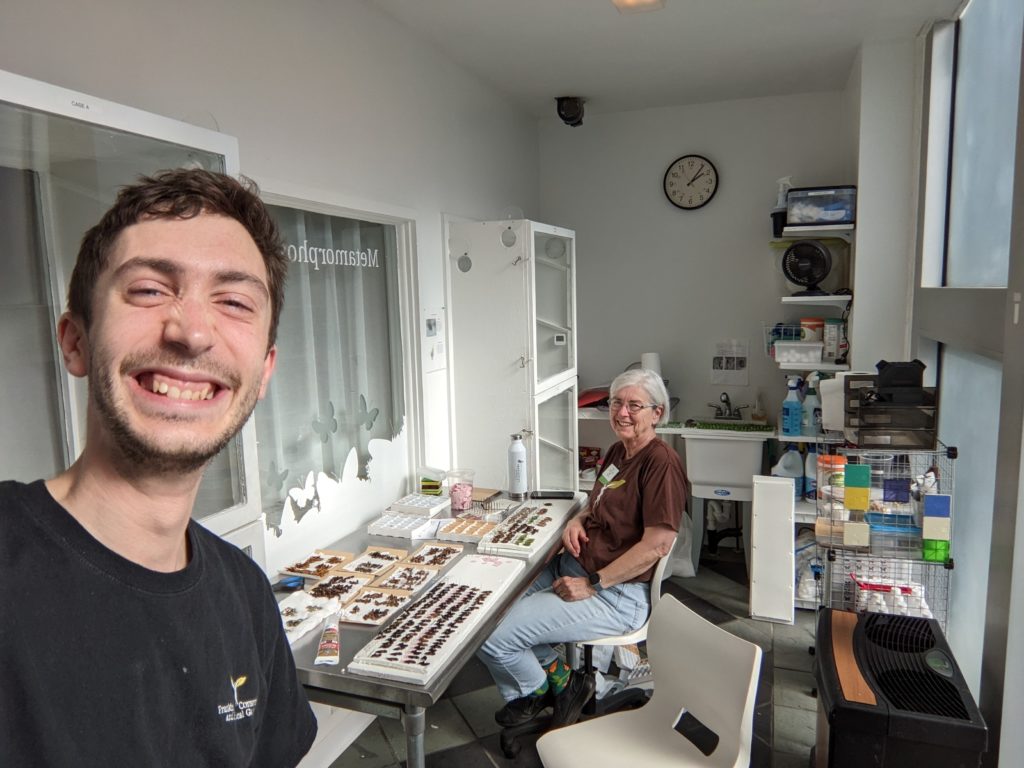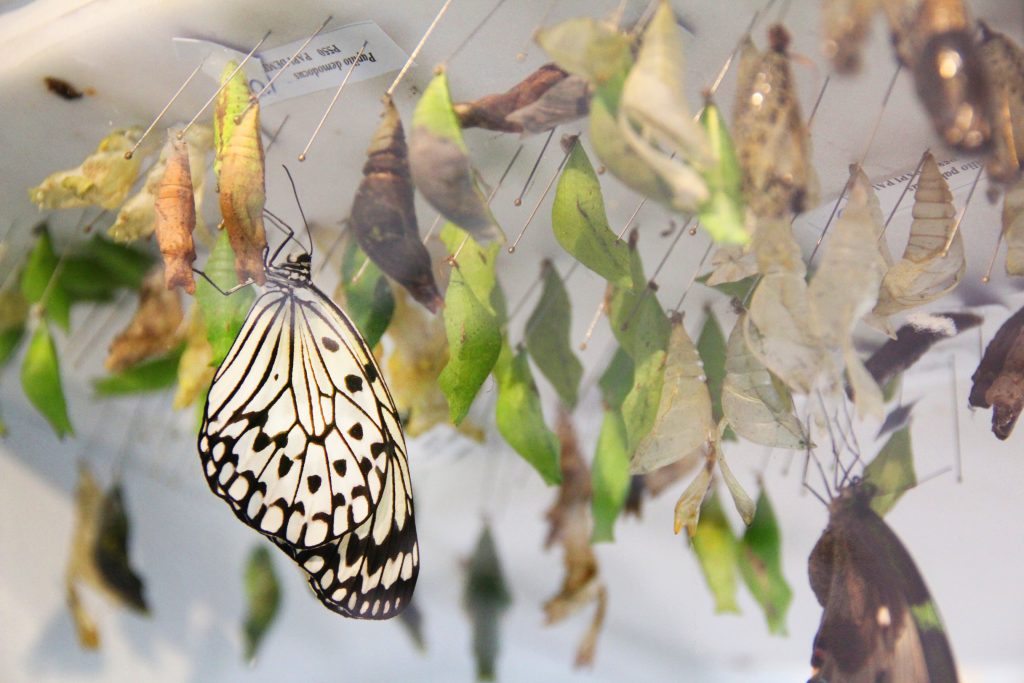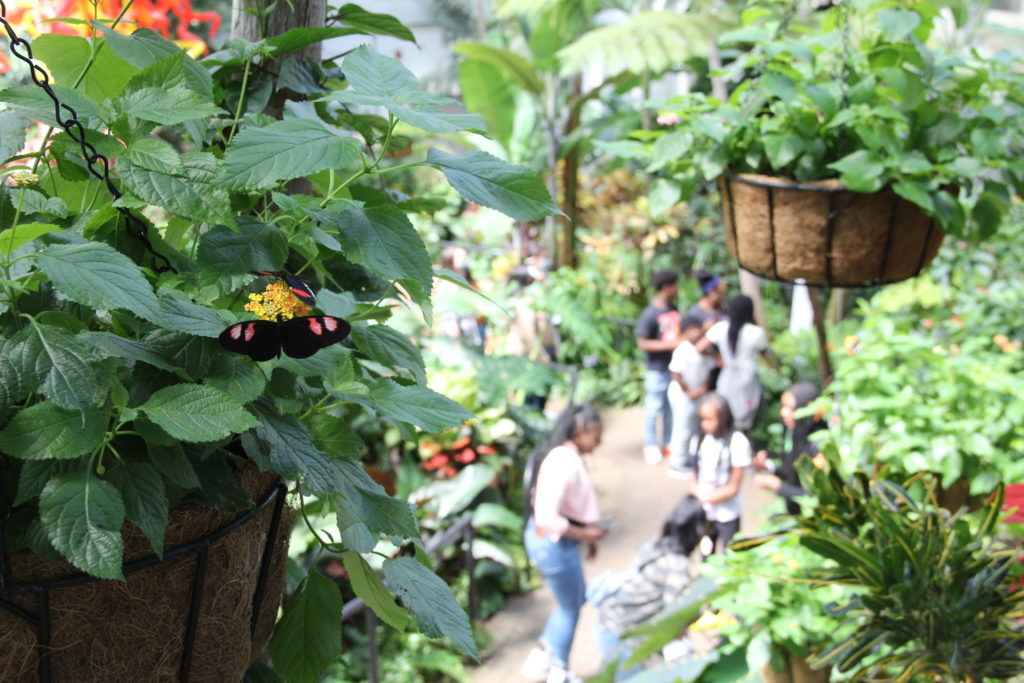Published February 22, 2023
- Home
- Conservatory Cultivators
- What Does a Butterfly Eat?
Published February 22, 2023
Morphos, Swallowtails and Monarchs. Crackers, Longwings and Malachites. If you watch closely and move with care, you’ll get a chance to encounter these butterfly species and many more in the Pacific Island Water Garden Biome during Blooms and Butterflies, opening on February 25.
Butterflies at the Conservatory have been a beloved annual springtime tradition since 1994! The Conservatory was the first botanical garden nationally to host a butterflies exhibition, and thanks to the unwavering support of our donors, members and friends, it has continued to grow and thrive every year since. We sat down with their head keeper, Exhibitions Technician Dylan Ecker, to chat about all things butterflies, how he cares for them throughout their life cycle and a few surprising (and even a little bit gross!) facts that visitors might not know about our fluttering friends.
“The new butterflies are like little babies,” Ecker said. “When they’re a caterpillar and they make their chrysalis, they have to dissolve their bodies in order to transform,” releasing a bi-product liquid called meconium in the process. Ecker doesn’t mind keeping the Metamorphosis Lab clean and tidy though. He relishes the process of receiving, unpacking and pinning 800-1,000 chrysalises from all over the world each week, nurturing them until they emerge after 7-10 days, depending on size. He loves “making sure they’re all coming out okay,” preparing their meals of fruit and simple homemade nectar, along with teaching the public about the entire butterfly life cycle.

Dylan and Volunteer Judy caring for butterfly chrysalises
Ecker got his start working at a wildlife rehabilitation center, where he enjoyed getting his hands dirty and doing the “gross stuff.” “To me, it felt like I was contributing something meaningful,” he explained. He still finds that sense of meaning here at the Conservatory, relishing especially “working with the people who come in. The kids who have this unabashed enthusiasm about seeing a butterfly. I love seeing them be interested.”
What fact amazes kids the most? “That butterflies don’t have mouths or teeth. Kids worry that they will land on them and they’ll bite or sting them. But they just have a proboscis that they can suck food up into.” Butterflies especially love to eat a plant native to the Americas called lantana. “It’s the perfect butterfly food,” Ecker explains. You’ll notice clusters of the colorful flowers placed throughout the exhibition, featuring delicate blooms perfectly shaped for a butterfly to sip from.
Another aspect of working with butterflies that surprised Ecker, now entering his second year as head technician, was that butterflies have “personalities, for lack of a better term.” Clippers, or Parthenos sylvia, are a species of fast-flying butterfly from Southeast Asia. When they’re resting they have their wings open instead of closed. “They’re very stubborn,” he laughed. “I have to go in there and put them in a box, I have to close their wings for them. Whereas the other ones, they let me scoop them up [to handle them].” More “cooperative” butterfly types include Morphos, Charaxes, Longwings or Heliconius, Catonephele and Archeoprepona.

A newly emerged butterfly in the Metamorphosis Lab
This year the exhibition will feature around 110 different species, coming from farms in Costa Rica, Ecuador, Australia, Asia, Africa and Florida. “Basically everywhere except Antarctica!” Ecker said. The Conservatory works with vendors who orchestrate the supply transfer from smaller farms including London Pupa Supply and Heliconius Butterfly Works. The entire exhibition requires permitting and compliance with the USDA, who works to ensure that non-native species are transported safely and contained securely. The double doors and checking procedures when guests and staff enter and exit the biome prevent breaches by butterflies who could become invasive species in our central Ohio environment if they were to escape.

Guests spotting butterflies in the Pacific Island Water Garden Biome
This year, 1,800 to 2,000 exotic butterflies will be flying around the Pacific Island Water Garden during the exhibition, feeding, resting and flying freely for the duration of their lifespan. “For this year, I’ll be here everyday,” Ecker said. Come chat with him if you get a chance–just look for the smiling fellow hanging around the Metamorphosis Lab!
Mark your calendar for Blooms and Butterflies Opening Day on Saturday, February 25, which will feature fairy-themed crafts and entertainment to kick the season off with a little extra magic. And during your visit this spring, keep an eye out for the accompanying Columbus Blooms exhibition, featuring more than 125,000 tulips, daffodils, pansies and other favorites popping up throughout the season.
Choose how you would like to give